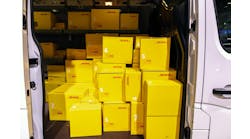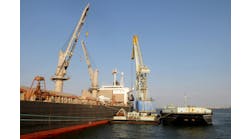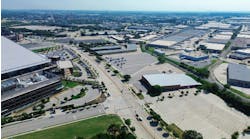Bob Wydra spends his days overseeing the transition of a former U.S. Army base into an extensive intermodal transportation facility in the heart of America. From his second floor office in the former Granite City Army Depot across the Mississippi River from St. Louis, he runs a 1,200-acre multi-use development that handles nearly 2,500 barges [roughly 4 million tons] of cargo annually, along with 32,000 rail cars and 40,000 trucks.
His is one of several inland port facilities in the St. Louis, Mo., metropolitan area. Combined, the various St. Louis ports handle just over 32 million tons of cargo each year.
"With globalization, transportation becomes even more critical to the site selection process and where businesses locate," says Wydra, the executive director of the Tri-City Regional Port District in Granite City, Ill. "Seventy percent of what comes across our docks is destined for ports all over the world. We're connected to the river, the railroad and the interstate highway system, so we take advantage of all the freight modes."
With rising fuel prices, transportation costs are a major consideration when it comes to where a company locates a new manufacturing or distribution facility. Finding a cheaper way to ship product is a continuous goal of business executives everywhere. That's why facilities such as the Tri-City Port District are so important.
"The Mississippi River opens up just below St. Louis," said Wydra. "Barges have to come down the Missouri, Illinois and Mississippi Rivers on smaller tows but, once they get below Lock 27, there aren't any more locks all the way down the Mississippi to the Gulf of Mexico."
Why is this important? Cargo capacity.
According to the Iowa Department of Transportation, one barge can carry the same volume of cargo as 15 jumbo hopper rail cars, or 58 tractor-trailers. That advantage increases exponentially once you get below Lock 27 and can start stringing together, say, a 15-barge tow, which offers the same cargo capacity as 225 rail cars, or 870 large tractor-trailers.
With today's fuel prices, that's a significant advantage when it comes to long-haul transportation costs. And that's just one of many factors businesses must take into consideration before deciding where to locate a new manufacturing or distribution facility.
For that reason, Expansion Management and Logistics Today magazines have teamed up for the past six years to produce our annual Logistics Quotient ranking of the most logistics friendly metropolitan areas in the United States. The study evaluates the overall logistics infrastructure of our nation's 362 metropolitan statistical areas (MSA) based upon 10 major categories, including the local transportation and distribution (T&D) industry, T&D work force, road infrastructure, road congestion, road conditions, interstate highway access, vehicle taxes & fees, railroad access, water port access and air cargo access.
Topping this year's list as the most logisticsfriendly metro in the U.S. is the New York-Newark-Edison MSA, followed by Houston, Minneapolis-St. Paul, Dallas-Fort Worth-Arlington, and Kansas City. Rounding out the top 10 are St. Louis, Chicago-Naperville-Joliet, Cleveland-Elyria-Mentor, Boston-Cambridge-Quincy, and San Francisco-Oakland-Fremont. (See chart on page 38 for an alphabetical listing of this year's Top 50 Logistics Cities).
How we measured the logistics infrastructure
The Logistics Quotient ranks metropolitan statistical areas according to 10 major categories, as described below. Together, they give a comprehensive overview of the many facets that make up a region's overall logistics infrastructure.
Transportation and warehousing Industry. This category looks at the depth and strength of the regional distribution industry, including the number of companies in the area engaged in transportation and warehousing, along with the annual revenue generated by the industry sector. Information comes from the U.S. Department of Commerce.
The top metropolitan areas in this category are New York, Los Angeles-Long Beach, Chicago and Miami-Fort Lauderdale. Houston and Dallas-Fort Worth tied for fifth.
Workforce. This category examines the depth and cost of the local logistics work force and includes the total annual payroll of companies in the transportation and warehousing industry sector, the total number of employees, the average salary and revenue per employee. Information comes from the U.S. Department of Commerce.
The top metropolitan areas in this category are St. Louis; Louisville; Miami-Fort Lauderdale; Laredo, Texas; and San Diego.
Interstate highway access. This category focuses on the interstate highway infrastructure and includes the number of interstate highways that pass through the metro area, as well as the number of interstate auxiliary routes (i.e., beltways, bypass, etc.). Information comes from the Federal Highway Administration.
The top metropolitan areas in this category are New York-Newark, Chicago, Baltimore, Dallas-Fort Worth and St. Louis.
Road and bridge conditions. This category includes the average roughness of the metro area's roads, as well as the percentage of bridges that are obsolete or structurally deficient, including five-year trends. Information comes from the Federal Highway Administration.
The top states in this category are New York, New Jersey, Massachusetts, Florida and Connecticut.
Road density and congestion. Whether or not a metropolitan area has adequate roads depends upon the amount of traffic using those roads. Clearly, what is considered an adequate infrastructure for Huntsville, Ala., is insufficient for a city like Atlanta. This category includes such things as roadway miles per capita, total miles of freeways, average daily freeway traffic, and average daily traffic per freeway lane. Information comes from the Federal Highway Administration.
The top metropolitan areas in this category are Pueblo, Colo.; Weirton-Steubenville, W.Va.-Ohio; Wausau, Wis.; Wichita Falls, Texas; and San Angelo, Texas.
Road infrastructure. This category looks into the future in terms of keeping up an adequate road infrastructure. It includes public roads mileage, capital outlay for roads and bridges, highway maintenance per mile and spending for highway law enforcement. Information comes from the Federal Highway Administration.
The top metropolitan areas in this category are Chicago, New York, Philadelphia, Pittsburgh and St. Louis.
Vehicle taxes and fees. This category includes highway user taxes and fees, as well as motor fuel excise taxes. Data on state and federal highway user taxes and fees was provided by the American Transportation Research Institute (as of April 2005), while data on motor fuel excise taxes was provided by the Federation of Tax Administrators (as of January 2006).
The states with the lowest annual state and federal highway truck user fees are Alaska, Georgia, Oklahoma, Hawaii and South Carolina.
Railroad infrastructure. This category includes the number of railroad carriers that service a metro. The data came from ALK Technologies, Inc., Princeton, N.J.
The top five metros in this category are Chicago, New York-Newark, Philadelphia, Pittsburgh and St. Louis.
Water port infrastructure. This category includes total tonnage for all ports located within the confines of the metropolitan area and comes from the U.S. Army Corps of Engineers Waterborne Commerce Statistics Center.
The top five metros in this category are category are New York-Newark, Memphis, Los Angeles-Long Beach, Miami-Fort Lauderdale and Chicago.
Air cargo infrastructure. This category includes the number of air courier companies, as well as the total air cargo tonnage for the metro. The data comes from the Federal Aviation Administration, the Bureau of Transportation Statistics,and the 2004 U.S. County Business Patterns, U.S. Census Bureau.
The top five metropolitan areas in this category are New York-Newark, Memphis, Los Angeles-Long-Beach, Miami-Fort Lauderdale and Chicago.
Bill King is the chief editor and Michael Keating is the senior research editor of Expansion Management magazine.
| Metropolitian Area | T & D I n d r u s t r y | W o r k F o r c e C o s t | R o a d I n f r a s t r u c t u r e | R | R | I | T | R a i l r o a d | W a t e r b o r n e C o m m e r c e | A |
| Atlanta-Sandy Springs-Marietta, Ga. | 7 | 66 | 289 | 345 | 4 | 12 | 3 | 34 | 95 | 8 |
| Baltimore-Towson, Md. | 21 | 70 | 157 | 199 | 288 | 3 | 152 | 34 | 24 | 36 |
| Birmingham-Hoover, Ala. | 48 | 74 | 190 | 238 | 210 | 23 | 34 | 24 | 38 | 67 |
| Boston-Cambridge-Quincy, Mass.-N.H. | 10 | 56 | 82 | 213 | 296 | 23 | 109 | 34 | 31 | 17 |
| Buffalo-Cheektowaga-Tonawanda, N.Y. | 44 | 31 | 6 | 106 | 347 | 81 | 352 | 6 | 60 | 57 |
| Chattanooga, Tenn.-Ga. | 85 | 51 | 269 | 206 | 50 | 52 | 29 | 63 | 57 | 107 |
| Chicago-Naperville-Joliet, Ill.-Ind.-Wis. | 2 | 26 | 103 | 348 | 87 | 2 | 294 | 1 | 5 | 5 |
| Cincinnati-Middletown, Ohio-Ky.-Ind. | 23 | 45 | 222 | 209 | 189 | 15 | 149 | 34 | 24 | 20 |
| Cleveland-Elyria-Mentor, Ohio | 25 | 18 | 146 | 150 | 192 | 5 | 208 | 17 | 14 | 44 |
| Columbus, Ohio | 21 | 53 | 146 | 250 | 192 | 36 | 208 | 34 | 52 | 34 |
| Dallas-Fort-Worth-Arlington, Texas | 5 | 46 | 121 | 262 | 110 | 4 | 65 | 7 | 94 | 7 |
| Davenport-Moline-Rock Island, Iowa-Ill. | 99 | 115 | 162 | 82 | 109 | 23 | 288 | 63 | 51 | 111 |
| Denver-Aurora, Colo. | 23 | 56 | 163 | 257 | 147 | 15 | 168 | 63 | 105 | 14 |
| Detroit-Warren-Livonia, Mich | 10 | 59 | 249 | 350 | 224 | 5 | 250 | 7 | 16 | 19 |
| Houston-Baytown-Sugar Land, Texas | 5 | 13 | 121 | 315 | 110 | 52 | 65 | 17 | 2 | 12 |
| Indianapolis, Ind. | 27 | 71 | 92 | 332 | 93 | 12 | 229 | 34 | 90 | 18 |
| Jacksonville, Fla. | 33 | 30 | 21 | 295 | 29 | 52 | 188 | 63 | 40 | 51 |
| Kansas City, Mo.-Kan. | 20 | 25 | 242 | 67 | 190 | 9 | 127 | 17 | 42 | 25 |
| Little Rock-North Little Rock, Ark. | 53 | 23 | 231 | 81 | 158 | 23 | 136 | 34 | 44 | 72 |
| Los Angeles-Long Beach-Santa Ana, Calif. | 2 | 11 | 44 | 267 | 297 | 9 | 306 | 102 | 29 | 3 |
| Louisville, Ky.-Ind. | 28 | 2 | 268 | 209 | 221 | 15 | 187 | 10 | 15 | 10 |
| Memphis, Tenn-Miss.-Ark. | 18 | 34 | 275 | 319 | 155 | 52 | 99 | 34 | 27 | 2 |
| Miami-Fort Lauderdale-Miami Beach, Fla. | 4 | 3 | 21 | 357 | 29 | 36 | 188 | 151 | 47 | 4 |
| Milwaukee-Waukesha-West Allis, Wis. | 32 | 19 | 209 | 344 | 52 | 36 | 295 | 63 | 59 | 37 |
| Minneapolis-St. Paul-Bloomington, Minn.-Wis | 14 | 26 | 161 | 258 | 22 | 5 | 135 | 7 | 54 | 16 |
| Mobile, Ala. | 97 | 79 | 190 | 222 | 210 | 52 | 34 | 24 | 22 | 93 |
| Nashville-Davidson-Murfreesboro, Tenn. | 36 | 76 | 225 | 231 | 73 | 36 | 57 | 102 | 36 | 40 |
| New Orleans-Metairie-Kenner, La. | 30 | 36 | 281 | 276 | 280 | 52 | 45 | 17 | 1 | 48 |
| New York-Newark-Edison, N.Y.-N.J.-Pa. | 1 | 34 | 5 | 234 | 346 | 1 | 159 | 2 | 3 | 1 |
| Oklahoma City, Okla. | 42 | 8 | 310 | 235 | 276 | 15 | 15 | 63 | 121 | 58 |
| Peoria, Ill. | 107 | 110 | 84 | 122 | 73 | 81 | 344 | 10 | 46 | 85 |
| Philadelphia-Camden-Wilmington, Pa.-N.J.-Del.-Md. | 7 | 87 | 83 | 294 | 324 | 15 | 162 | 3 | 8 | 9 |
| Pittsburgh, Pa. | 26 | 103 | 104 | 121 | 329 | 23 | 332 | 4 | 7 | 34 |
| Portland-Vancouver-Beaverton, Ore.-Wash. | 19 | 48 | 221 | 286 | 223 | 36 | 271 | 10 | 30 | 21 |
| Richmond, Va. | 43 | 124 | 175 | 102 | 172 | 15 | 90 | 225 | 55 | 51 |
| Sacramento-Arden-Arcade-Roseville, Calif. | 39 | 37 | 44 | 298 | 297 | 52 | 306 | 34 | 86 | 29 |
| Salt Lake City, Utah | 40 | 24 | 163 | 302 | 16 | 23 | 154 | 102 | 110 | 32 |
| San Antonio, Texas | 41 | 65 | 121 | 167 | 110 | 23 | 65 | 102 | 112 | 33 |
| San Diego-Carlsbad-San Marcos, Calif. | 29 | 5 | 44 | 218 | 297 | 23 | 306 | 102 | 80 | 30 |
| San Francisco-Oakland-Fremont, Calif. | 9 | 20 | 44 | 189 | 297 | 12 | 306 | 34 | 12 | 6 |
| Savannah, Ga. | 84 | 71 | 289 | 244 | 4 | 52 | 3 | 63 | 75 | 134 |
| Seattle-Tacoma-Bellevue, Wash. | 12 | 28 | 70 | 228 | 253 | 52 | 272 | 15 | 9 | 11 |
| St. Louis, Mo.-Ill | 12 | 1 | 187 | 218 | 186 | 5 | 164 | 5 | 10 | 28 |
| Tampa-St. Petersburg-Clearwater, Fla. | 31 | 9 | 21 | 362 | 29 | 23 | 188 | 310 | 19 | 27 |
| Toledo, Ohio | 59 | 67 | 146 | 261 | 192 | 15 | 208 | 34 | 48 | 54 |
| Tulsa, Okla. | 45 | 47 | 310 | 112 | 276 | 81 | 15 | 34 | 62 | 60 |
| Virginia Beach-Norfolk-Newport News, Va.-N.C. | 38 | 64 | 201 | 247 | 185 | 36 | 108 | 34 | 35 | 62 |
| Washington-Arlington-Alexandria, D.C.-Md.-Va.-W.Va. | 16 | 48 | 175 | 305 | 222 | 9 | 124 | 63 | 24 | 23 |
| Wichita, Kan. | 78 | 42 | 236 | 39 | 65 | 81 | 165 | 63 | 148 | 68 |
| Worcester, Mass. | 83 | 114 | 17 | 96 | 329 | 52 | 127 | 63 | 31 | 107 |
Source: Expansion Management and Logistics Today Magazines, 2006 Logistics Quotient.
How the Cities Stack Up
Overall logistics infrastructure
- New York-Newark
- Houston
- Minneapolis-St. Paul
- Dallas-Fort Worth
- Kansas City
- St. Louis
- Chicago
- Cleveland
- Boston
- San Francisco
Transportation and warehousing industry
- New York-Newark
- Los Angeles-Long Beach
- Chicago
- Miami-Fort Lauderdale
- Houston/Dallas-Fort Worth (tie)
Transportation and warehousing workforce
- St. Louis
- Louisville
- Miami-Fort Lauderdale
- Laredo, Texas
- San Diego
Road density and congestion
- Pueblo, Colo.
- Weirton-Steubenville, W.Va.-Ohio
- Wausau, Wis.
- Wichita Falls, Texas
- San Angelo, Texas
Interstate highways infrastructure
- New York-Newark
- Chicago
- Baltimore
- Dallas-Fort Worth
- St. Louis
Railroad Infrastructure
- Chicago
- New York-Newark
- Philadelphia
- Pittsburgh
- St. Louis
Water port infrastructure
- New Orleans
- Houston
- New York-Newark
- Baton Rouge, La.
- Chicago
Air cargo infrastructure
- New York-Newark
- Memphis
- Los Angeles-Long Beach
- Miami-Fort Lauderdale
- Chicago


